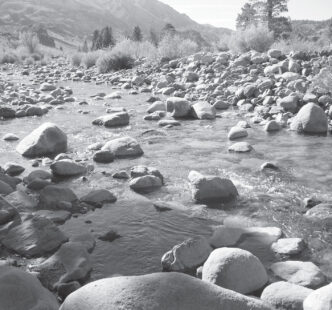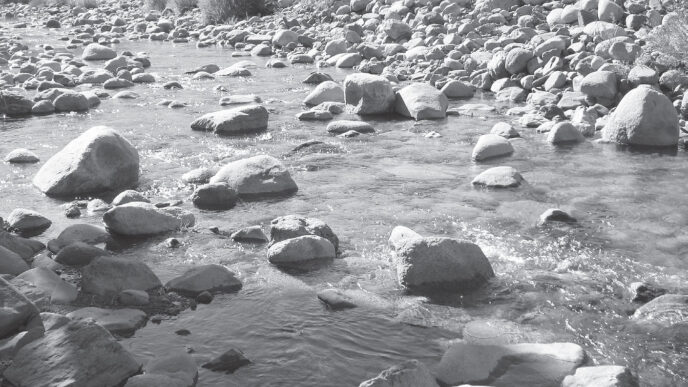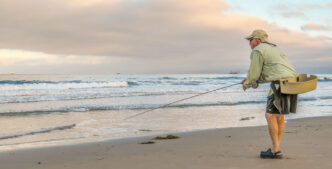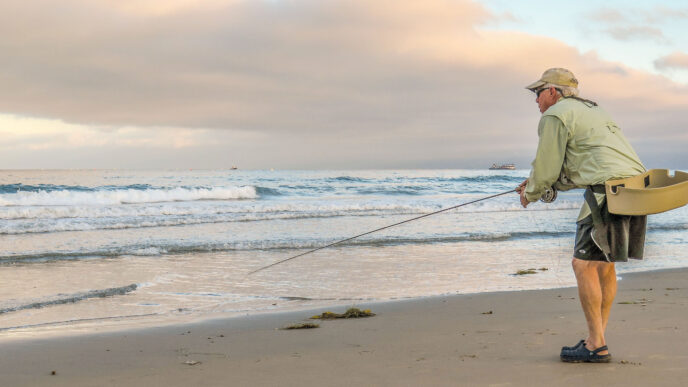Of all the rivers I’ve fished, the Russian remains closest to my heart. I make no claims for its majesty. Up against the McCloud or Hat Creek, it’s a poor cousin at best. It offers no mountain vistas, like the blue-ribbon streams of the Sierra Nevada, and nobody I’ve met has ever swooned at the sight of it. The fishing, it must be said, can range from indifferent to downright awful in dry winters. When the water’s low in its shallowest stretches, you might mistake it for a grungy catfish slough in the Sacramento Delta. But the Russian is the first and only river I’ve lived on, and therein lies the source of my affection.
I landed on its banks by accident. In those long ago days, I was escaping from San Francisco, joining the exodus of hippies from a city gradually becoming unrecognizable (and unaffordable) to us. I’d never visited Sonoma County, but when some friends bought a 40-acre parcel on a hillside overlooking the Alexander Valley, I decided to investigate. In Healdsburg, still a small town then, with rowdy Mexican bars on the plaza and copious Americana, I found a realtor who’d listed a rental in the valley — a “trailer home,” as she described it.
That put me off my feed. A trailer home? For me, a college graduate? But my attitude changed when I saw the location, a 14-acre property fronting on the Russian River. The trailer wasn’t nearly as hideous as I feared — a two-bed, two-bath doublewide — and it had a wraparound deck with a view over vineyards to a great oxbow of the watershed. The view put me in mind of Tuscany, and that, along with the budget rent of $200 a month, sealed the deal.
I took to country living right away. As a child, I’d wanted to be a cowboy, and I felt a bit like one on what I thought of as my “rancho.” I loved the solitude, the elbow room, the wildlife, and the roar of the river after a storm. Rain pounding on the trailer’s roof, cold nights by the wood stove, cold beer in the fridge, books for free from the Healdsburg Library. Whiskey and cribbage with an elderly neighbor for a penny a point — they were satisfaction enough.
I discovered fruit trees on the rancho — apple, plum, persimmon, and peach — that still produced in spite of being untended. The peaches were the sweetest I’d ever eaten. The trees were planted in a meadow along a creek where the steelhead made their redds and spawned in season. Mushrooms grew there, too, and I learned to harvest puffballs and “pinkies,” as the locals called them — Agaricus campestris, similar to button mushrooms — that were superb when sautéed in butter and splashed with a hit of sherry.
In my new Red Wing boots, I explored every inch of those 14 acres. I’d never been a birder, had even poked fun at them, but now I carried a Peterson’s field guide everywhere and marked up the checklist at the back — Bullock’s orioles nesting in a tall pine, snowy egrets, once a black-crowned night heron, and the stupendous pileated woodpeckers as big as crows. Above the meadow, a white-tailed kite often hovered, searching for voles and mice and stooping to prey on them with a swift and terrifying force. Ospreys patrolled the river with the same fervor, and I almost cried the day I watched one fly off with a steelhead clutched in its talons.
The rancho had a pond, as well, where the mallards and coots swam around. It was murky and packed with frogs, hundreds of them. If I walked the perimeter and caught them basking, they leaped back into the water with a squeal. They could have been fleeing from a burning building. Months went by before it occurred to me to fish the pond. I had no luck with my trout flies, but an old popping bug did the trick, and I hooked a two-pound largemouth, probably descended from the stock some farmer had planted ages ago. I cooked a largemouth once, and only once. It tasted of frogs and murk.
That popper and others like it — bushy, wiggly-legged, plain ugly — also worked well on the river’s smallmouths. It’s not generally known how good the smallmouth fishing can be on the Russian, especially in the early spring after the first blast of heat, when the bass go on the spawn. They’re terrific fighters and strike with a viciousness that takes your breath away. Fat little specimens, they have the kind of redemptive energy that comes after a long torpor — like yourself, say, after you’ve recovered from an indulgent Super Bowl weekend. It helped to use a quirky stop-and-go retrieve to imitate a baitfish, too.
Along with the poppers, I had some success with Humpies and even with the Elk Hair Caddis in the larger sizes. Big and showy, that was the key. Often I caught 15 or 20 smallmouths in a morning or an afternoon, whether in full sunshine or under a cloudy sky. But when summer came and the temperature rose above their comfort zone, they hunkered down in the depths.
The smallmouths were great fun, but the steelhead became my obsession. I knew plenty about rainbow trout, but almost nothing about their sea-going relatives. I’d fished for them only once, on a dismal trip from San Francisco to the lower river and the famous pools around Guerneville before I moved to the valley. A few bright, fresh steelhead were being hooked, but there were so many anglers casting to them that I couldn’t find a rock to stand on, as the saying goes.
On the rancho, though, I had a mile or so of the Russian pretty much to myself. Sometimes a driftboat passed by, but that was about it. Access to my stretch was almost impossible to achieve. The vineyards around it were all fenced, and the creek ran too high in winter for anybody to walk in along the bed. You could reach the river only via a dirt road leading to my place, and only one person had the realtor’s permission to use it. That was my friend Paul Deeds.
I’ve written about Deeds before, so I’ll make it brief. He farmed prunes in the valley, but all he cared about, really, was steelhead fishing. At first, he viewed me as an interloper on his property, exactly the sort of city slicker who figured in his worst nightmares, but eventually he saw how inept I was and how little competition I offered. In other words, he took pity on me. Ours was a master-and-pupil relationship, and he slowly began to share with me the tactics he’d developed over a lifetime.
Deeds was an expert at reading the river. He knew exactly where the steelhead held and when they were likely to move. Often he didn’t fish for days, because there’d be no point. The water was too discolored, he’d say, or it needed some rain to freshen it. When I started ordering flies by mail, a dozen different patterns, Deeds laughed and called me a sucker. “You people from San Francisco,” he chuckled, shaking his head. He tied his own flies, of course, and relied on three or four patterns only. He didn’t even bother to name them, referring instead to the “red-and-white” or the “black-and-gray.”
If I hadn’t met Deeds, I doubt I’d have caught more than a couple of steelhead, and those by sheer chance. But he taught me enough savvy to locate the choice holes myself, and I gained the confidence and patience — for steelhead fishing is a waiting game — to succeed. I wasn’t as discerning as Paul about the optimal conditions, though. I fished every day unless the river was totally out of shape. It might be for only an hour, but I fished. That was the joy of having the Russian in my backyard. There was no need to mount an expedition and drive two hundred miles before wetting a line.
I thought I’d live in the trailer for no more than a year, but I stayed for five. Even when I became established as a writer and could afford a change, I resisted it. Instinct must’ve told me that I’d never again find my life so entwined with a river, and that led me to draw out the experience for awhile longer. Ultimately, I gave in to the temptations of the big world beyond the valley, and I can’t say I regret it. Yet here on a cool, gray morning in Dublin, Ireland — ideal weather for steelhead fishing — I sit thinking about the Russian and hoping fate grants me one more chance to see my old rancho.
















